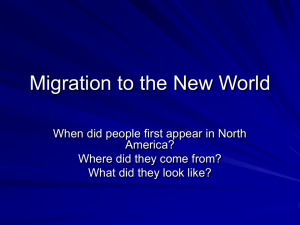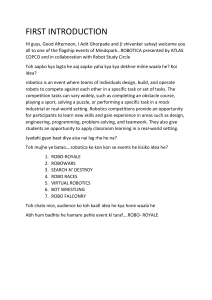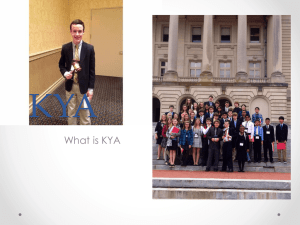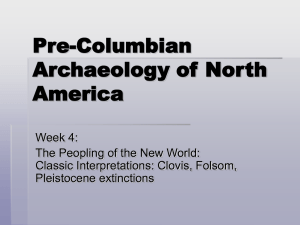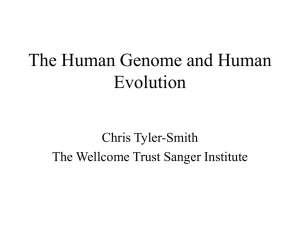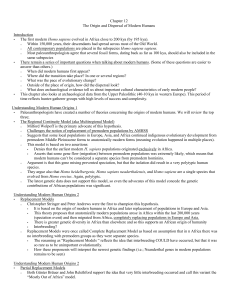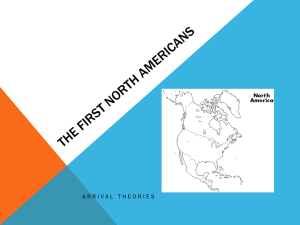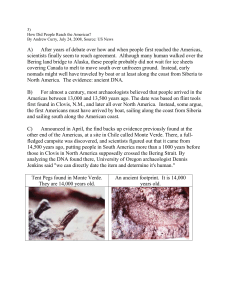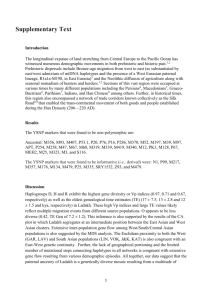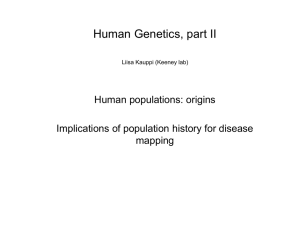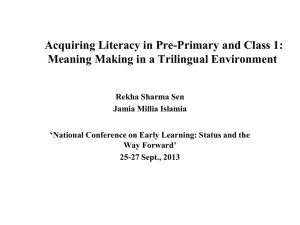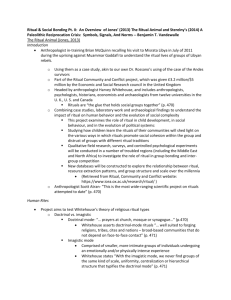Peopling of the Americas
advertisement
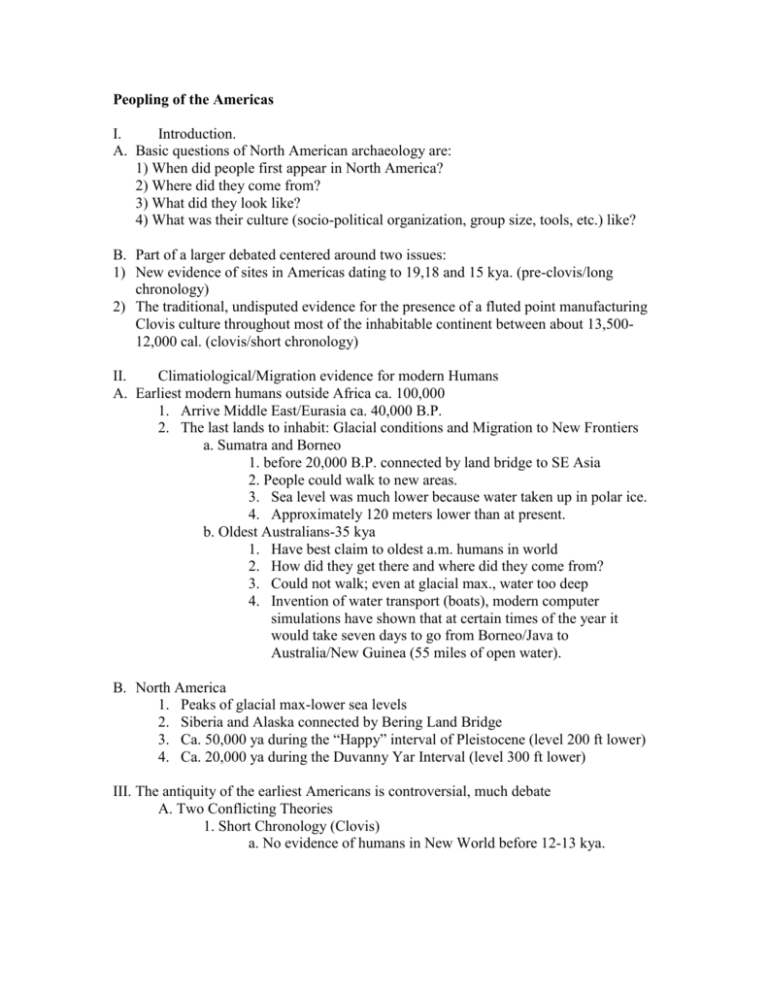
Peopling of the Americas I. Introduction. A. Basic questions of North American archaeology are: 1) When did people first appear in North America? 2) Where did they come from? 3) What did they look like? 4) What was their culture (socio-political organization, group size, tools, etc.) like? B. Part of a larger debated centered around two issues: 1) New evidence of sites in Americas dating to 19,18 and 15 kya. (pre-clovis/long chronology) 2) The traditional, undisputed evidence for the presence of a fluted point manufacturing Clovis culture throughout most of the inhabitable continent between about 13,50012,000 cal. (clovis/short chronology) II. Climatiological/Migration evidence for modern Humans A. Earliest modern humans outside Africa ca. 100,000 1. Arrive Middle East/Eurasia ca. 40,000 B.P. 2. The last lands to inhabit: Glacial conditions and Migration to New Frontiers a. Sumatra and Borneo 1. before 20,000 B.P. connected by land bridge to SE Asia 2. People could walk to new areas. 3. Sea level was much lower because water taken up in polar ice. 4. Approximately 120 meters lower than at present. b. Oldest Australians-35 kya 1. Have best claim to oldest a.m. humans in world 2. How did they get there and where did they come from? 3. Could not walk; even at glacial max., water too deep 4. Invention of water transport (boats), modern computer simulations have shown that at certain times of the year it would take seven days to go from Borneo/Java to Australia/New Guinea (55 miles of open water). B. North America 1. Peaks of glacial max-lower sea levels 2. Siberia and Alaska connected by Bering Land Bridge 3. Ca. 50,000 ya during the “Happy” interval of Pleistocene (level 200 ft lower) 4. Ca. 20,000 ya during the Duvanny Yar Interval (level 300 ft lower) III. The antiquity of the earliest Americans is controversial, much debate A. Two Conflicting Theories 1. Short Chronology (Clovis) a. No evidence of humans in New World before 12-13 kya. b. Crossed Bering Land Bridge during last glacial maximum, moved between major ice sheets-Laurentide (C. Canada), Labrador (E. Canada), and Cordilleran (W. Canada). All touched at glacial maximum. c. Ice free areas developed during last periods (20-12 kya) and people crossed Beringia, following larger herds of bison, Mammoth, and Mastodon. d. People carried large spears-Clovis Points and lived in highly mobile groups traveling rapidly across unglaciated N. America into S. America in very short period of time. Called the Paleoindians. e. Possible that the rapid expansion of humans in conjunction with warmer climate (ca 10 kya) caused extinction of megafauna in New World. f. Many sites in New World date to this period-Clovis, NM; Blackwater Draw, NM; Kimmswick, Missouri (clovis and mastodon), Shoop, PA; Williamson, VA; Debert, Nova Scotia. Hundreds of Clovis points found isolated in N. Am. 2. Long Chronology (PreClovis) a. Humans in many migrations in New World, as early as 30-40 kya. b. Smaller groups than indicated by Clovis hypothesis, largely a wood and bone tool industry. Also chopper and scraper industry. c. Postulated due to recent finds of sites which date to before 15 kya. d. Meadowcroft Rockshleter, PA (16-19,5 kya) artifacts include stone blades, scrapers and knives. e. Wilson Butte Cave, Idaho (14,5 kya) f. Most compelling are Mexican and S. American sites (1) Flea Cave, Peru 14,7 kya (2) Pedra Furadarockshleter, Brazil 30-12 kya (3) Monte Verde, Chile excavated by Tom Dillehay (a) One area of site dates to ca. 13 kya houses, preserved by an overlayer of peat. Wood, bone, skin, meat, botanicals are extremely well preserved. (b) Ambiguous lower level of three possible cultural features and some stone tool fragments dated to 33 kya. Affiliation unclear, but more recent research suggests early dates very compelling. B. Both of these postulate a Bering Land Bridge crossing, but there are two others: 1. Coastal Route Theory a. Eastern Asian groups-largely sea-faring people traveled in boats along coastal edges. b. Some areas ice free and those were internal routes. c. Could explain rapid colonization of middle and south america d. Evidence provided by several skeletons (Alaska skeleton 10,500 bp.) suggest maritime adaptation. e. Technology similar to Dyuktai, Siberia. 2. Atlantic Maritime Theory a. European moderns ca. 20,000 ya traveled via boat along coasts and entered through the east u.s. b. Sites such as Cactus Hill, VA, Topper, SC, Wacissa River, FL, Meadowcroft, PA all contain materials dating before 15 kya. c. Points similar to thin, Solutrean points. IV. So why all the controversy? A. Some researchers suggest multiple migrations from many routes. 1. Groups came from Bering, West Coast, and East Coast. 2. Differences in regions suggested. B. Problems with some early sites. 1. Pre-13 kya dates from sites suggests we didn’t know to look for anything earlier. a. if there is nothing older than that then why dig any deeper. b. occupation may have been more ephemeral than first believed (sexier to think of first Americans as “Big Game” Hunters roaring across the americas). 2. Hard to change old ideas, new dating techniques are still unverified. 3. Meadowcroft Rockshelter, thought to be contaminated by coal. 4. Tools very different from later Clovis. C. Among the more recent sites that come generally accept are: 1. Monte Verde in Chile (13 kya, Tom Dillehay), 2. Meadowcroft Rockshelter in Pennsylvania (19kya, James Adovasio), 3. Bluefish caves in the Yukon (13,000-11,000 BC), 4. Florida sink hole sites (14 kya, Webb). 5. Cactus Hill, VA (17 kya) Meadowcroft Rockshelter http://members.delphi.com/MCCONAUGHY/web/Meadowcroft/meadow.htm Cactus Hill http://www.levymultimedia.com/April/0406campfire.htm Monte Verde http://www.cabrillo.cc.ca.us/divisions/socsci/anthro/index/mverde.html Aucilla River http://www.flmnh.ufl.edu/natsci/vertpaleo/aucilla/arpp01.htm Biological Evidence and NAGPRA 1. What did they look like? 2. What was their culture? I. What did they look like? A. Very few skeletal remains dating to this time period (>9,000 B.P.). 1. Browns Valley, Wyoming 2. Horn Shelter, Texas 3. Hourglass Cave, Colorado 4. Spirit Cave, Nevada 5. Wizard Beach, Nevada 6. Gore Creek, British Columbia 7. Kennewick Man, Washington B. Metric calculations show that they look like modern Ainu or Pacific Islanders more than modern Amerinds. C. Enter the Kennewick Controversy: 1. Skeleton found in 1996 in southeastern Washington. 2. Initially excavated as an early “caucasoid” historic skeleton, because no obvious native american traits. 3. Later analysis showed age of 8,500 b.p. so Native American communtiy involved through NAGPRA. a. enacted in 1990 to protect and repatriate native american remains. b. Umatilla indian tribe claimed as ancestor c. Scientific community said couldn’t determine cultural affiliation because too old and non-native features. d. Went to court and natives won, but scientists from Smithsonian allowed one year for study. C. Biological Analysis 1. Sinodonty a. shovel shaped upper incisors b. single rooted first lower premolar and upper second molar. c. Shared by northern asians and modern native americans 2. Sunodonty a. non-shovel shaped incisors b. multiple rooted premolars and molars c. shared by southern asians and europeans. 3. Genetic research. a. mtDNA-mitochondria passed down by women, shows relationships. b. All modern, native americans are descended from a single group of Asians. c. But, earlier migrations of people from Europe could have died out. D. Linguistic evidence. Joseph Greenberg suggested three separate migrations: 1. Amerind before 11,000 BP, 2. Na-Denes (Athabaskan) ca. 9000 Bp, 3. and AleutEskimo about 4000 Bp. II. Culture during the end of the Pleistocene. A. Humans expand into the Arctic area from Europe and northeast Asiaabout 40,000 BP. Wurm glaciation; steppe tundra; site clusters at Malta (25,00013,000 BP) and Dyukhtai(14,000-1 2,000 BP) with microblades. B. Ice Age megafauna important, although maybe not as important as previously thought. C. Subsequent, later Paleo-Indian groups diversified away from big game hunting. Some general summary conclusions: 1. Later Paleo-Indian life-ways lasted fiom about 8900 to 8000/6000 BC, depending on area. These were very stable life-ways despite the rapid changes taking place in the natural environment. 2. Most later Paleo-Indians became generalized hunter-gatherers; focal pedestrian bison and caribou hunters are found on the Great Plains and along the cold northern fringe, respectively. 3. In general, sites are small with a thin artifact layer. Some are base camps and the majority are special activity sites, such as quarries, kills, and plant harvesting locales. Because of the rapidly changing landscape, these sites often occur today in unexpected places (e.g., in the middle of a field - far from water). 4. These life-ways probably involved small family groups that followed an annual pattern of movement through very large areas. Favored sites were probably occupied year-after-year and family groups aggregated with other bands when food was abundant. 5. Population densities were still very small. However, population size gradually rose during this 1000-3000 year period until "free roaming" was forced to an end by regional "packing." The most rapid increases in population occurred in the most food abundant areas, causing an imbalance in population distribution across the continent. 6. Probably highly mobile patrilocal and exogamous bands that interacted frequently for information, goods, mates, entertainment, ritual. A highly flexible social organization with extensive kin ties and marriage alliances that allowed movement back and forth from one band to another. III. Conclusions. A. Biologically modern humans of a generalized Asian stock entered the Americas from northeast Asia after 20,000 BP. B. The earlier evidence than Clovis 12-13,000 BP, with a hint of earlier occupations. C. People were hunter-gatherers who pursued big-game, smaller animals, perhaps fish and sea mammals, and some wild vegetable foods. People "dribbled" across in small family groups. D. Multiple migration routes possible: 1. Bering Land Bridge but 2. West coastal route 3. East coast route
